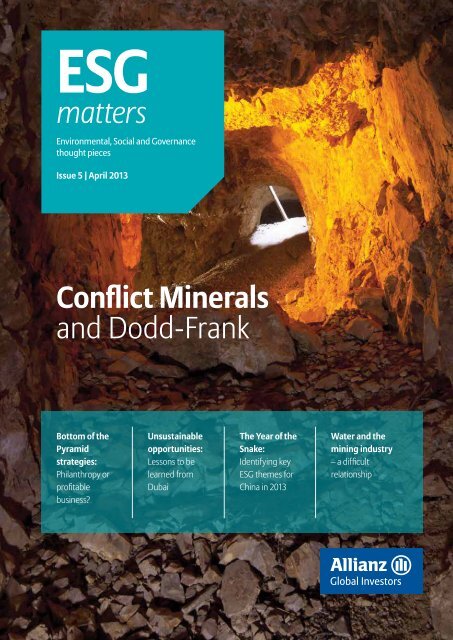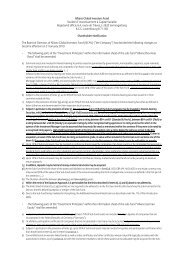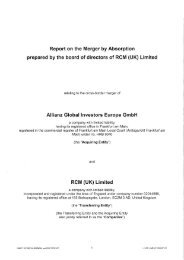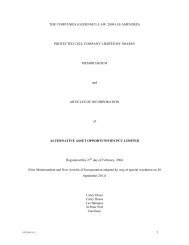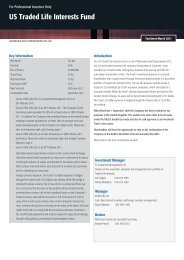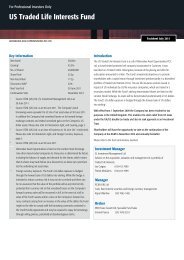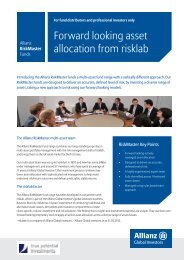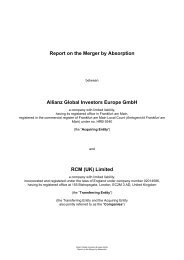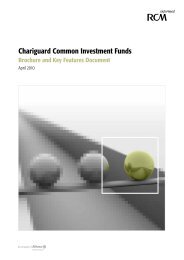ESG Matters, Issue 5, April 2013 - Allianz Global Investors
ESG Matters, Issue 5, April 2013 - Allianz Global Investors
ESG Matters, Issue 5, April 2013 - Allianz Global Investors
Create successful ePaper yourself
Turn your PDF publications into a flip-book with our unique Google optimized e-Paper software.
The <strong>Global</strong> <strong>ESG</strong> TeamLONDONBozena Jankowska – <strong>Global</strong> Co-Head of <strong>ESG</strong>Adam JohnsonProduct Specialist,<strong>Global</strong> Sustainability & EcoTrendsMarissa Blankenship – <strong>ESG</strong> AnalystAdam Johnson – Product Specialist, <strong>Global</strong>Sustainability & EcoTrendsJeremy Kent – <strong>ESG</strong> AnalystDear readerPARISDavid Diamond – <strong>Global</strong> Co-Head of <strong>ESG</strong>Welcome to the 5th edition of <strong>ESG</strong> <strong>Matters</strong>, showcasing thought pieces on <strong>ESG</strong> themes andtrends from the <strong>Global</strong> <strong>ESG</strong> Team.In this edition the team explore a number of <strong>ESG</strong> topics which are material and have animpact on investment analysis. <strong>ESG</strong> issues have an effect on shaping the development ofregulations, how companies operate, how different sectors are set to grow or decline, and,thus, <strong>ESG</strong> issues will play their part in future economic growth. For example, would you haveever expected the Dodd-Frank Act to have a US$3bn impact on the technology and jewelleryindustries? Our cover-page article explains how Article 1502 of Dodd-Frank is set to havemuch wider implications on a range of US companies than one would expect.<strong>ESG</strong> issues are not just about risks and mitigating these risks. They also pose opportunities. Inthis edition, for example, we evaluate the stress mining places on water reserves and theresulting water pollution hazards as well as highlight how stricter regulation and publicscrutiny are providing opportunities for the clean technology sector to address these issues.By better understanding the material <strong>ESG</strong> issues and factors at play within our globaleconomy we can not only help shape more sustainable development but also provide ourclients with better investment decisions.Anne-Claire Abadie – <strong>ESG</strong> AnalystJulian Bras – <strong>ESG</strong> AnalystMarie-Sybille Connan – <strong>ESG</strong> AnalystPierre Dinon – Proxy Voting SpecialistMathilde Moulin – <strong>ESG</strong> AnalystFrankfurtIoannis Papassavvas – Proxy Voting SpecialistRainer Sauer – Proxy Voting SpecialistHONG KONGHenrike Kulmann – <strong>ESG</strong> AnalystSAN FRANCISCOVerity Chegar – <strong>ESG</strong> AnalystContact detailsFor any further information please contact:Adam JohnsonAdam Johnson adam.johnson@allianzgi.co.uk +44 20 7065 1457<strong>Allianz</strong> <strong>Global</strong> <strong>Investors</strong> (UK) Ltd.1st Floor155 BishopsgateLondon EC2M 3AD www. allianzgi.co.uk 0800 317 573© 2012 <strong>Allianz</strong> <strong>Global</strong> <strong>Investors</strong>All rights reserved2
Executivepay<strong>ESG</strong> <strong>Matters</strong> | <strong>Issue</strong> 5040812 1824Contents04 Bottom of the Pyramid strategies: philanthropy orprofitable business?08 Unsustainable opportunities: lessons to be learnedfrom Dubai12 LEGISLATIVE DRIVE TOWARDS <strong>ESG</strong>: conflict minerals anddodd-frank18 THE YEAR OF THE SNAKE: IDENTIFYING KEY <strong>ESG</strong> THEMES FORCHINA IN <strong>2013</strong>24 WATER AND THE MINING INDUSTRY – a difficultrelationship3
ottom of thepyramid/ section 1Bottom on the Pyramidstrategies: Philanthropy orprofitable business?Mathilde Moulin examines how some companies are approachingdoing business with the largest consumer demographic in theworld, the world’s poorest, who make up two thirds of the world’spopulation.The Bottom of the Pyramid (BoP) is the term used toclassify people who live on less than US$8 a day inpurchasing power parity (ppp) terms. This equates toaround US$2.4 a day in Ethiopia, US$3.2 in India andUS$4.8 in China.Individual daily income (2005 US$ in purchasing power parity terms)Mathilde Moulin<strong>ESG</strong> Analyst,Paris0.5billion2 billionTop of the pyramid:>US$55Middle of the pyramid:>US$8 to US$554 billionBottom of the pyramid:
<strong>ESG</strong> <strong>Matters</strong> | <strong>Issue</strong> 5Among the Bottom of the Pyramid (BoP), those wholive on less than US$2 a day ppp are what we call“ultra poor”. They barely have any purchasing powerand only humanitarian aid can help them to achieveminimum acceptable living conditions. Those thatlive on US$2 to US$8 a day ppp may have a tinyamount of purchasing power but they still havehuge unmet needs such as access to water,electricity, heat, healthcare, food, financial servicesetc.The Bottom of the Pyramid (BoP) segment, apopulation of roughly 4 billion living in mostlydeveloping countries, through sheer numbersalone represents a significant economicopportunity for companies that want to enlargetheir consumer base. To address this segment ofcustomers, companies look to implement “BoPstrategies” offering low cost, quality products orservices adapted to both the needs of the BoPpopulation and to the constraints of its environment,while trying to remain profitable. Each deal is of lowvalue but this should be counterbalanced by thehigh volume of transactions.BoP strategies are seen as a means to generate newsources of revenues and growth. By developingproducts and services adapted to the BoPpopulation, companies can take advantage ofpotential growth drivers with little competition. BoPstrategies allow companies to enter new markets,to deepen their consumer base and ultimately togenerate extra profits. This is of particular interestfor companies acting in developed, mature marketswhere growth is scarce.Beyond that, as defined by C.K Prahalad and S.LHart in ‘The fortune at the Bottom of the Pyramid’ in2001, “the prospective rewards include growth,profits and incalculable contribution to humankind”. Indeed, as most of BoP strategies deal withmeeting very basic needs, such as access to food,healthcare, energy etc., they help to improve livingconditions. This also serves to increase a company’semployee engagement and motivation. Thestrategies unite the employees around newprojects and improve a company’s external andinternal reputation. BoP strategies also improvecompanies’ licence to operate. By demonstratingthat they care about the poorest people’s needsand that they contribute to the fight againstpoverty, companies increase their local legitimacyand earn the right to develop more products/services in the future. BoP strategies are 5
ottom of thepyramid/ section 1typically classified as ‘BoP 1.0’ or ‘BoP 2.0’. BoP 1.0 focuses on theproduct or the service itself by adapting it to meet the BoPpopulation needs and to facilitate access to it. This can be achievedby various means:• Price reduction is the most simple – making a product or aservice affordable for the BoP population.• However, innovation in distributing the product/service isoften required to reach people in remote areas.• Further to this, product/service adjustments may be needed tomeet the BoP’s specific needs, such as a milk based productthat can be stored at room temperature (this example isexplained more fully below)It may be that a company can simply address one of these factors toservice the BoP or it may be that a company will have to adapt two orall three of them.Price reduction is a mechanism commonly used by thepharmaceuticals sector, with companies selling medicines at lowerprices in emerging countries in order to reach more patients. Forexample, Novo Nordisk sells insulin in 49 less developed countries ata price 20% lower than the one in force in the developed world.An example of innovation in a company’s distribution channels canbe seen with the subsidiary of the cement group Holcim in Mexico.The subsidy decided to do away with the middlemen from the saleschain, as they drove up prices and restricted supply. Instead theyopened distribution centres in remote areas where cement can bebought in small quantities at lower price by people from localcommunities.Another example is the way Essilor sells spectacles in India. Usingmobile vans, specialists from Essilor travel into rural regions andprovide free eye exams and low cost lenses and glasses (from US$3to US$5) that are assembled on site immediately. This allows peoplewho would have never gone to a city, as the transportation alonemay cost them US$6 on average, to benefit from a free consultationand affordable glasses. This should have a positive impact oneducation and ability to work.Procter & Gamble is a good example of a company adjusting itsproducts to meet BoP’s needs. The company sells a hand wash thatrequires less water for rinsing. This is distributed in water stressedregions. Nestlé makes food products reinforced with vitamins forcountries where people have deficiency. Microcredits developed bythe banking sector are another good example of services adaptingto meet specific BoP needs. Microcredit loan cycles are shorter thantraditional loans and payments are made weekly or even daily insome cases.BoP 2.0 goes beyond BoP 1.0. Not only does it adapt products orservices for the BoP but it also encourages the involvement of thelocal population as producers, suppliers and distributors. Localpeople are seen not only as consumers but also as business partners.With the BoP 1.0 strategy there is some concern that offeringunderprivileged people affordable products is not addressing thecore issue of poverty. BoP 2.0, by developing a business model basedupon local resources and local partners, addresses this concern andhelps sustainable development.Danone is one of the most advanced companies in this field. Forexample, in India Danone launched Fundooz, a milk based productfor children that is reinforced with vitamin A, iron, zinc and iodine –the four nutrients that Indian children have most deficiency. Notonly is it sold at affordable price, the group also innovated at allstages of the business chain from supply to distribution to involvethe local population. Danone formed partnerships with local milkproducers, produced the product locally and relied on a network ofnumerous small distributors to sell the products in schools and inthe streets to reach children more easily. Fundooz has also beendesigned to be kept at room temperature to prevent any food safetyissue.The Bipbop program developed by Schneider Electric is anothergood example of a BoP 2.0 strategy. Schneider Electric creates6
<strong>ESG</strong> <strong>Matters</strong> | <strong>Issue</strong> 5The prospective rewardsinclude growth, profits andincalculable contribution tohuman kind.solutions for reliable, affordable access to clean energy in rural areasin developing countries such as the In-Diya LED lighting system. Thissystem is deployed in India and Africa and generates light from solarpanels or batteries. In parallel, the group commits to train localentrepreneurs to ensure the maintenance of the lighting systems,change the batteries, collect payments and use those paymentsadvisedly. Schneider Electric, therefore, provides local communitieswith both electricity and jobs while generating revenue forthemselves.It must also be noted that companies have a duty to respect the BoPand must not look to exploit the BoP just for a quick profit. The veryfact that the target audience is so poor and generally lacks educationand that the market lacks suitable regulatory frameworks meansthat they are often very vulnerable. Companies must be responsiblewhen they follow BoP strategies, looking to work with the localcommunities to do what is best for all, not just for their sales.Irresponsible marketing and coercion by overzealous sales force touse unsuitable products have marred some companies BoPstrategies and reputations in the past.It is not all easy going, therefore. BoP business models are highlychallenging and companies implementing BoP strategies face anumber of issues regarding innovation needs, market knowledgeand profitability. These barriers to entry prevent some companiesfrom even trying to branch out into BoP strategies.As explained, successful BoP strategies require a high level ofadaptation and innovation, be it on the products and servicesthemselves or on the way they are produced, marketed anddistributed. The main issue for companies is to offer a qualityproduct or a service at low costs while dealing with a range ofproduction and/or distribution constraints.BoP strategies are really a laboratory of innovation for companies.They require investment in time, money and dedicated skills.Companies need to have a thorough knowledge of the market theywant to enter in. Dealing with an informal economy, red tape,corruption, and finding reliable local partners can be very difficult.Thorough knowledge of the market is also essential in order to offera product or a service that really fits local needs. The lack ofknowledge of specific local conditions is a source of frustration forsome BoP projects. That is the case for a strategy deployed by VeoliaEnvironnement in partnership with Grameen.Veolia and Grameen built a water treatment plant to supply water totwo Bangladeshi villages at a relatively low cost, whose only otheroption was to use spring water that was free but contaminated byarsenic. At the beginning, the local population would not drink thewater coming from the treatment plant and would continue to drinkthe arsenic contaminated one. Veolia Environnement asked a teamof anthropologists to conduct a local survey to understand whypeople would not buy Grameen Veolia water. The results of theinvestigation showed that villagers lacked knowledge of the exactconsequences of arsenic on health – cancer and internal lesions inlater life. Villagers did not understand the choice between theimmediate cost of the water supplied by Grameen Veolia and thepossible longer term risks.At the same time, the researchers found that there was a socialstigma associated with arsenicosis. People would not buy theGrameen Veolia water because they feared that others would thinkthey were affected by the disease. After hearing this, an educationalprogram was set up in partnerships with religious leaders, teachersand local authorities to explain to villagers the benefit of GrameenVeolia water. This finally meant the project succeeded.The greatest challenge for the BoP strategies is to achieveprofitability and to be considered as credible business projects.What with the high costs and low prices, margins are low andrequire large volumes to provide any return on investment.Strategies usually take a longer time to break even compared tostandard projects. That is why many give up on BoP strategies ornever expand them elsewhere. Furthermore, BoP strategies areoften managed by the philanthropic department of companies.They tend to be disconnected from the core business and as such,they do not benefit from usual business reporting lines, resources ordecision-making frameworks. Sometimes feasibility studies are notconducted and profitability is an after-thought. In the end, BoPstrategies migrate into corporate social responsibility projects/charity when they “should look like core business projects. It hasto be about generating revenues and selling products to thepoor – not broad based poverty alleviation” as BoP expert ErikSimanis said.Thus, it appears that one of the greatest obstacles to BoP strategiesare companies themselves. Often many companies lack thecapabilities and organisational support to make the strategies work.At the end of the day, even if BoP strategies are seen solely asphilanthropy, at least they contribute to alleviate poverty and that isalready quite an achievement. 7
8Unsustainableopportunities/section 2
<strong>ESG</strong> <strong>Matters</strong> | <strong>Issue</strong> 5Unsustainable opportunities:Lessons to be learned fromDubaiBozena Jankowska questions whether Dubai’s rapid development issustainable over the long term.Bozena Jankowska<strong>Global</strong> Co-Head of <strong>ESG</strong>,LondonJimi Hendrix’s song ‘Castles made of Sand’seems strangely apt when one thinks ofDubai in particular the lyric “... so castlesmade of sand fall in the sea, eventually”.Dubai is one the fastest growing cities inthe world and home to the world’s mostambitious engineering projects such as theimpressive Burj Khalifa tower (the world’stallest building at 830m) and the first-manmadeisland, The Palm. One has to wonderwhat the environmental and social price ofsuch fast paced development is and howsustainable it is over the long term.It is estimated that the Burj Khalifa tower’speak electricity demand, for example, isestimated at 50MVA, equivalent to roughly500,000 100-watt light bulbs. It is expectedto use an average of 950,000 litres of watera day and during peak cooling conditions,the tower will require the equivalent to thecooling capacity of about 10,000 tons ofmelting ice.Focusing on the energy needs of thebuilding can lead one to forget the impactthat Burj Khalifa’s had on society. Thebuilding took some 22 million man-hoursto complete, in the main by underprivilegedAsian immigrants paid US$4 per day. It hasbeen reported that many of these workersworked in dangerous conditions whileliving in squalid quarters with little or nolabour rights protection. Workers such asthese continue to make up the majority ofDubai’s 2 million population.Much of Dubai’s economic growth hasbeen down to the availability of cheapenergy. Dubai’s oil reserves havediminished significantly and are expectedto be exhausted in 20 years’ time. Tourismon the other hand has become the majordriver of the Dubai economy contributingaround 60% to the emirate’s gross domesticproduct (GDP) in 2012. Given theimportance of tourism to Dubai, thepressure to build ever grander structuresand attractions to lure in the tourists canonly serve to act as a self-perpetuatingspiral of unsustainability if allowed to go onunmanaged.The problem is not just centred on Dubai.According to Maplecroft’s Emissions 9
Unsustainableopportunities /section 2Energy Use Index (CEEI), the United ArabEmirates (UAE) ranked at the top carbonpolluter, representing the highest energyconsumption per capita in the world. This isreflective of UAE’s near 100% reliance onfossil fuels and the use of energy intensivedesalination plants in order to producefreshwater. Much of which goes onmaintaining the lush tropical gardens,landscapes and swimming pools of hotelresorts and golf courses, indoor ski resorts(which have an equally high energy andcarbon footprint) and provide airconditioningfor huge spaces (such asshopping malls) and buildings.Unsurprisingly, therefore, the UAE consume83% more water than the global averageaccording to analysis by Booz & Company.Residents and businesses have disregardedthe consequences of their water usage toenjoy the short term benefit more commonin countries with ample rain and fullaquifers. However, with the population ofUAE increasing at a rate greater than 2% ayear, and with a rapid expansion of theeconomy, there must be a growingrecognition by government that currentwater consumption patterns areunsustainable.Back in Dubai, engineering feats such theman-made islands of The Palm and TheWorld (a man-made archipelago whichcreated hundreds of kilometres of newwaterfront for Dubai before hitting fundingissues since the financial crisis and whosefuture now lies in doubt as although theislands have been created only a showroomhas been built so far) have courtedcontroversy. Environmental groups havecriticised the environmental impacts ofthese structures during the building stagesand the immediate negative impacts theyare expected to have on the local marineenvironment. It took 94 million cubicmetres of sand and 7 million tonnes of rockto create the artificial island for The Palm.The construction process created vastplumes of sediment that turned theaquamarine waters milky and temporarilydamaged marine life. It also destroyedturtle nesting sites and the only knowncoral reef along Dubai’s coast. There arearguments, however, being made that thelonger-term environmental impacts ofboth man-made islands could be beneficialto the local marine environment as theyhave created the perfect conditions forcoral reefs to thrive. Only time will tell.Aside from the environmental impacts, thebigger question continues to remain thesame. How sustainable will it be to meet allthe water needs of these newdevelopments and what will the resultingenergy needs contribute to the existingcarbon footprint of Dubai? With sea waterlevels predicted to rise as climate changeaccelerates and with the islands only being4m above sea-level, one can only wonderwhether we are looking at a ticking timebomb. Over time, will rising sea levelsencroach on the Dubai’s prime waterfrontproperties turning them into underwatercities and lost investments?The forgotten human factorMeanwhile, the human element of Dubai’sconstruction boom has been forgotten inthe glitz of luxury hotels, apartments andshopping destinations. It is estimated thatthere are now one million migrant workersin Dubai. The bulk of Dubai’s constructionworkforce is composed of Asianimmigrants, mainly from areas of extremepoverty in India, Pakistan, Bangladesh andNepal. The plight of many of these workers,in particular the standards of their workingand living conditions, is increasinglycoming to light. Lured by the promise of abetter way of life with a salary of US$450/month, workers may pay up to US$3,000 torecruitment agents to make the trip toDubai. Often this is done with borrowedmoney or family land sold in the belief thatwithin 18 months the debt can be repaid.On arrival in Dubai, the reality for many ismuch starker. Real salaries are actuallyusually around US$180-240/month,passports can be confiscated, and someworkers are expected to work 12 hour days,six days per week often in temperaturesabove 40°c, living in poor conditions andwith no worker rights or means ofimproving their situation.A greener Dubai?Early signs that Dubai is taking small stepsto become greener are becoming evident.In 2012, the local leaders unveiled a 48 sq.km (18.5 sq. miles) solar energy park thatpromises 1,000 megawatt output. The localenergy authority is considering a carbontrading scheme to reduce its greenhouseemissions, while a local green buildingcouncil is active in organising a range of‘green events’, with translation into actionyet to be seen. One major project that isclaiming green credentials is the DubaiPearl, a US$5.8bn multi-use complexdevelopment that promises the luxuryexpected of Dubai but which alsoincorporates the principles ofenvironmental sustainability into its designand use. The complex is aiming to achieveLEED gold certification which provides aframework for applying green practices inthe building construction, use andmaintenance. The project also aims to besocially responsible with respect to theconstruction immigrant labour force.Perhaps valuable lessons can be learnedfrom its sister emirate, Abu Dhabi’s MasdarCity? At a projected cost of US$22 billion thecity will rely entirely on solar energy andother renewable energy sources, with asustainable, zero-carbon, zero-wasteenvironment that will be car free.Incorporating long-term, sustainablebuilding and development strategies intothe future growth of Dubai would seem likea sensible way forward. It certainly wouldstart to address future challenges broughton by depleting non-renewable energysources, climate change, water availabilityand population growth.While one can only marvel at the humaningenuity that lies behind the engineeringfeats of Dubai’s transformation from a 10
<strong>ESG</strong> <strong>Matters</strong> | <strong>Issue</strong> 5sleepy fishing town to today’s metropolis, there are, equally, lessons to belearned for the future. Although Dubai may not be suffering theenvironmental and social consequences of its real estate growth today, if leftunmanaged they are likely to have an impact on the emirates futuresustainability and growth. It is easy to be caught up in the here-and-now andfocus on short term opportunities but for long-term investors with a longterminvestment horizon it would seem intuitive to incorporate sustainabilityinto their investment process. Factors which may not be playing out today areoften ignored because they are deemed to not be material or are simplykicked down the road to be dealt with at a later date, by which time it may betoo late. ...Burj Khalifa...took some 22 millionman-hours tocomplete, in the mainby underprivilegedAsian immigrants paidUS$4 per day. It hasbeen reported thatmany of these workersworked in dangerousconditions....11
12Legislativedrive towards<strong>ESG</strong>/section 3
<strong>ESG</strong> <strong>Matters</strong> | <strong>Issue</strong> 5Legislative drive towards<strong>ESG</strong>: Conflict Minerals andDodd-FrankThe Dodd-Frank Act represents the most comprehensive financialregulatory reform measures in the us taken since the GreatDepression. Verity Chegar takes a closer look at one particulararticle of the Act, Article 1502, that is set to have much widerimplications on a range of US companies than one would expect.Verity Chegar<strong>ESG</strong> Analyst,San FranciscoThe phrase “financial reform” does not make onenaturally think of electronics and jewellery. But anew Securities and Exchange Commission (SEC)rule based on Dodd-Frank financial legislation willrequire companies who use gold and other specificmetals in their products to say whether the metalscome from regions of Africa where the miningindustry has been found to support armed conflictand human rights abuses.The Dodd-Frank Wall Street Reform and ConsumerProtection Act of 2010 contains a small sectionknown as Article 1502, the conflict minerals rule,which goes beyond bank regulation. Article 1502requires US-listed companies to disclose certainminerals sourced from the Democratic Republic ofthe Congo (DRC) and eight surrounding regions ofconflict. The area has seen years of violent war andhuman rights infractions. Insurgents have takendirect control of mining operations and haveimposed illegal taxes on miners to fund theinsurgence. The militia has been known for youthconscription, citizen intimidation, and acts of sexualand general assault. Human rights advocates havepushed industry to acknowledge buying mineralsfrom the region meant lining the pockets of therebels and equated to implicitly committing humanrights violations. Article 1502’s inclusion in theDodd-Frank legislation and its adoption by the SECconnects the dots between commerce and thesocial and human rights impact of doing business inwar torn regions.<strong>Investors</strong> will find the SEC’s adoption of the conflictminerals rule particularly interesting because of itsimplications for the financial materiality ofenvironmental and social impacts of companyoperations. The SEC acknowledged “the socialbenefits [of Article 1502] are quite different fromthe economic or investor protection benefits thatour rules ordinarily strive to achieve.” Nevertheless,the SEC’s final ruling in August 2012 made theregulation material for any manufacturer listed onthe New York Stock Exchange or NASDAQ, therebyencompassing most US traded companies. The rulerequires issuers to take responsibility for a rawmaterial’s provenance no matter where along thesupply chain the material was acquired. Finishedgoods producers must enlist the help of all tiers oftheir supply chains to comply with the regulation.That makes conflict minerals relevant not only forcompanies listed on US exchanges, but also for anyglobal company that supplies a manufacturer listedon a US exchange. Along the supply chain, eachcompany has both customers and suppliers forwhom it is accountable and from whom it willrequire information to meet the regulation.Cooperation is needed at all tiers for companies tobe able to say confidently whether or not theirmaterial inputs supported armed conflict. Thisrequires immense transparency and strong socialsupply chain management, which are two tenantsof sustainable investing. By adopting the rule, theSEC has made the societal impacts of the 13
legislativedrive towardsesg/section 31)2)corporate supply chain a material financial concern. <strong>Issue</strong>rs don’twant their businesses to be associated with human rights abuses. Acompany’s reputation can influence investor capital flows, customeragreements, and employee retention—all important parts of acompany’s success.Article 1502 defines conflict minerals as cassiterite (ore refined intotin), columbite-tantalite or “coltan” (processed into tantalum), gold,and wolframite (ore refined into tungsten) mined in the DemocraticRepublic of the Congo or any of eight adjoining countries. Companiesmust first identify which of their products contain gold, tantalum,tungsten, or tin. Then, issuers who use those minerals “that arenecessary to the functionality or production of a product” mustdetermine whether they came from the DRC or one of the eight“covered regions” surrounding the DRC. Next, a company thatsources conflict minerals must ascertain whether the minerals theybought through the supply chain supported armed groups in theregion. Beginning May 31, 2014, listed companies must file a FormSD (special disclosure) for the calendar year <strong>2013</strong> explaining all thesesteps and the results of their due diligence. If a company finds itsproducts qualify as “DRC conflict-free,” the process ends with theannual filing. If the company’s materials are found to come from amine under armed control, the company must issue a conflictminerals report discussing further due diligence and listing theproducts that are not DRC conflict-free.1) Tungsten or Wolframite ore.2) Gold / Quartz Nugget.All of these steps require enormous research, communication, andaccountability for companies to determine their exposure manystages upstream in their supply chains. The task is not small. Theymust figure out if their purchase orders bought products thatcontained parts from different suppliers who bought materials thatcame from rocks pulled out of the ground in certain areas of Africa.Thus, it is not surprising that the SEC has granted companies a twoyeargrace period (four years for smaller companies) during whichcompanies may disclose in their filings that their products are “DRCConflict Undeterminable.” That grace period will lapse 13 November2014 for large companies and 2016 for small companies. Laggardswho report an undeterminable status will have to explain to theirstakeholders why they did not comply with the regulation, and whytheir supply chain management is below best-in-class.The SEC estimates the initial cost of compliance with the conflictminerals rule to be between three and four billion dollars, andongoing annual compliance to be roughly US$200-600 million. Theexchange estimates 4,500 companies will need to produce auditedconflict minerals reports. Many issuers share the same suppliers,however, so an industry collective approach has been leveraged toreduce the cost of duplicating efforts to investigate one supplierused by many companies. The estimated cost of compliance for alarge company totals US$6.5 million for internal and supplier due14
<strong>ESG</strong> <strong>Matters</strong> | <strong>Issue</strong> 5Electronics companies ranked by progress on conflict mineralsIntelHPSanDiskPhilipsAMDRIMAcerDellAppleMicrosoftMotorola MobilityNokiaPanasonicIBMSonyLGSamsungToshibaLenovoCanonNikonSharpHTCNintendo4*5*6*7*2*5*4011*14*13*15*13*15*88819*1724* 6032* 5448482127272727353533444240403838Companies 30% and overCompanies between 10 and 30%Companies 10% and below* Lighter shaded area represents2010 score, if available0 10 20 30 40 50 60 70Percentage of progress toward responsible sourcing on conflict mineralsSource: Enough Project, www.enoughproject.org, August 2012.diligence, IT systems, external audits, reporting, and consultingservices. Companies who already have strong supply chainmonitoring systems in place, especially supplier audits and ITsystems, will avoid the bulk of this cost.The electronics industry provides the largest market for tantalumand tin, making technology companies the most active respondersto the regulation. Technology companies use more than 60% of theworld’s tantalum for capacitors. Capacitors can be found in all kindsof electronic applications from mobile phones and PCs to cars.Rwanda, one of the “covered countries” surrounding the easternDRC, produced 14% of the global supply of tantalum in 2011 makingthe region a significant supplier of tantalum. Tantalum is the metalmost relevant to Article 1502 by a margin. The covered countriessupply 14% of the world’s tantalum compared to only 4%, 3%, and 2%of the global tin, tungsten, and gold.The Electronic Industry Citizenship Coalition (EICC) and the <strong>Global</strong>e-Sustainability Initiative (GeSI), two technology industry coalitions,launched the Conflict Free Smelter (CFS) Program to aid membercompanies in meeting the Article 1502 regulation. Realizing thedifficulties involved in tracing the chain of custody of a piece of rockthrough a region of armed rebels, the groups focused on smelters asthe point in the supply chain close enough to the source to guaranteeprovenance (from a conflict mine or not) and sufficiently followdownstream. Over the past few years, the program has worked toenrol smelters around the world into the audit program, whichrequires transparent reporting and third party audits. The programhas certified 16 tantalum and 12 gold smelters. There are still fewerthan three certified tin smelters, and no tungsten smelters.Intel has been a leader in tracing its supply chain to the smelter andreporting on progress. The company has already certified that 15
legislativedrive towardsesg/section 3all of the tantalum smelters used throughout its microprocessorsupply chain have been certified conflict free. The companypublished clear goals and progress reports in its sustainability reportand annual report. Intel, HP, and GE started an initiative to share thecost of due diligence audits born by the smelters in the CFS program.The smelter incentive program has encouraged smelters to seekconflict-free certification. Multiple conflict-free smelters for eachmetal are needed to support the demand following Article 1502.Companies need the choice to switch suppliers in order to certifytheir supply chains as conflict free.Tin is also predominantly used in the electronics industry owing toits use in solders. About 2% of tin comes from the DRC. An innovativeapproach to monitoring chain of custody of the minerals from themine to the smelter is the bagging and tagging system developed byITRI Tin Supply Chain Initiative (iTSCi) in Rwanda. The iTSCi conflictfreemining members deposit tin ore into bags that are labelled witha bar coded tag that identifies the mine of origin and its conflict freecertification. This bagging and tagging system has been the mostsophisticated conflict-free method introduced to date. IBM donatedthe technology and funding for the iTSCi program.The jewellery industry consumes more than half of the world supplyof gold. The DRC and surrounding regions do not produce ameaningful amount of the global gold supply, although reportednumbers are probably not accurate. NGO Enough Project reports allof the gold produced in eastern DRC is smuggled out of the country.The Responsible Jewellery Council has begun a Chain-of-Custodyprogram, but it does not include audits of smelters or mines and willfall short of the due diligence requirements prescribed in Article1502. Signet Jewellers has joined the Conflict-Free Smelter programpromoted by the EICC and GeSI. Zale Corporation mentions conflictminerals in its annual report, which it filed after the SEC adopted therule. However, behind tech companies, most other affectedindustries have been slow to react to the regulation.Many challenges remain for the conflict minerals regulation to curbhuman rights abuses in the DRC. Companies may choose to sourcethe minerals they need from producers outside the coveredcountries. Africa is not the majority supplier of any of the minerals inquestion, and companies may find it easier to avoid any associatedThe SEC estimates the initialcost of compliance with theconflict minerals rule to bebetween three and fourbillion dollars, and ongoingannual compliance to beroughly US$200-600 million.reporting required from buying metals from the DRC andsurrounding countries. Opponents of divestment argue that thevictims of human rights abuses would be doubly punished if theirlivelihoods are further threatened by a decrease in activity from thisimportant export economy. Companies must invest considerabletime and effort into finding reliable information about theprovenance of materials used in components and parts theypurchase. This takes time and laggards may run out of time beforeMay 2014. Miners who earn conflict-free certification may bag andtag their product only to find that the chain of custody is interruptedby armed groups, or that artisanal miners misappropriate the iTSCitools after hours.While there are obstacles to achieving the goals Article 1502 set outto achieve, there are positive takeaways already from this legislation.Companies at all stages of the supply chain have had to worktogether to increase transparency and communication on the socialimpact of their business relationships. Companies have shown acommitment through individual leadership and coalition work togain better insight into their supply chains. Suppliers, whether or notthey are subject to the SEC rule, have shown a commitment totransparency for the benefit of their customers. One importantlesson from this multi-year process is that companies, when put tothe test, are able to more accurately monitor their supply chains andtake ownership for the social implications of their relationships.Companies who have best-in-class supply chain oversight and16
<strong>ESG</strong> <strong>Matters</strong> | <strong>Issue</strong> 5Africa mapfor conflictmineralsCentral AfricaRepublicCongoDemocraticRepublic of theCongo (DRC)UgandaRwandaBurundigreatest transparency stand to lead their industriesand suffer lowest additional cost to achieve what isrequired from this and future legislation.There is more work to be done before companiesare ready to report to the SEC on their conflictminerals exposure. One very important lessonfrom company responses to date is that socialsupply chain oversight is achievable and can be donewithin a relatively short time frame without damage tocompetitive positioning. The implications are verypositive for investors. If companies can successfullymonitor raw materials and social activity at their sources,companies will show a greater ability to manage social andenvironmental conditions at those sources. As companiestake responsibility for the impact of purchase decisions and theeffects those commercial decisions have on human beings, theoutlook for US corporate <strong>ESG</strong> performance stands to continue toimprove.Zambia17
THE year ofthe snake/section 4The Year of the Snake:Identifying key <strong>ESG</strong>themes for China in <strong>2013</strong>With the Chinese New Year celebration now behind us and the newChinese government having formally taken office at the annualsession of the National People’s Congress, Henrike Kulmannintroduces the key <strong>ESG</strong> themes for China over the next twelvemonths.Henrike Kulmann<strong>ESG</strong> Analyst,Hong KongChina’s People’s Congress recently confirmed itsnew leaders Xi Jinping (President) and Li Keqiang(Premier) at the National People’s Congress whichconcluded on March 17th <strong>2013</strong>. Although we do notexpect any drastic policy changes as both Xi and Lihave already played a significant role in settingpolicy in the last few years as deputies to Hu Jintaoand Wen Jiabao respectively, it was interesting tosee that pollution has risen high on the agenda forthe new leaders as public fury about China’spollution crises increases.The key topics we believe are likely to shape thecountry’s <strong>ESG</strong> agenda next year include:• Corruption• Food safety• License to operate• Air pollutionSocial stability: one of the drivers forgovernment action on <strong>ESG</strong> improvementsThe four key topics mentioned above are very muchrelated to Chinese officials’ goal of striking the rightbalance between sustainable growth andmaintaining social stability. Income disparity in18
<strong>ESG</strong> <strong>Matters</strong> | <strong>Issue</strong> 5China has been increasing and is well abovethe warning line for social stabilityaccording to the Gini Index, whichmeasures wealth distribution and equality.Intentions to reform the hukou system(household registration system) to givemigrant workers living in urban areas fairaccess to public services such as education,housing service and health care, can beseen as an attempt by the government toavoid the formation of a permanent urbanunderclass and to reduce social tension.Social media in China, which helps tospread news quickly and is difficult tocontrol, has enabled ordinary peopleexpress their dissatisfaction with corruptionand income equality via these channels.The increasing number of protests whichare fuelled by people’s concerns overpollution and corruption give reason tobelieve the new leaders will have to followup on their National People’s Congress’spledges to tackle these issues. This will notleave companies untouched.Corruption2012 saw a number of Chinese governmentofficials involved in high profile corruptionscandals that were revealed via the Chineseinternet and which, in the end, led to theirdismissal. Bo Xilai, the former Partysecretary in Chongqing and member of thePolitburo, was possibly the one case thatshook the Communist Party the most andwhich received media attention worldwide.Bo Xilai was tipped for a place among theParty’s ruling elite before arrested onmultiple counts of corruption and misuse ofoffice. His wife has been convicted of themurder of a British businessman, NeilHeywood, a close business connection tothe Bo family. The scandal plunged thepublic image of Chinese governmentofficials into crisis.First signs of the government putting moreeffort into tackling corruption came inOctober 2012 – the eve of the 18th PartyCongress – when He Guoqiang, Politburomember and secretary for Party disciplinaryinspection, announced that 660,000 Partyofficials had been under investigation forcorruption in the past five years, with 19
THE year ofthe snake/section 424,000 officials identified as criminalsuspects and handed over to judicialauthorities. The new leadership sent asecond signal when Wang Qishan – whohas earned a reputation as an effectivecrisis manager and has a deepunderstanding of the financial system –was appointed as head of the Party’s antigraftcommission in November 2012 tocrack down on corruption. While intent tofight corruption has always been part of thepolicy announcements after leadershiptransition, his appointment may pointtowards a more serious effort to fightcorruption.While we do not expect the corruptionclean-up to have any immediate impact oncompanies, state owned companies (SOE’s)will be the first who are likely to seepressure during any clean-up as they arereliant on government contracts andlicenses. If there is greater emphasis on theenforcement of the rule of law, sectors thatmight be exposed to risk include financials,real estate, telecommunications,construction and transportation.Food safetyAnother key topic, partially caused bycorruption through the bypassing ofproduct quality control, is food safety. Thevast number and scale of food scandals inChina explain the significance of this topic.According to MSCI, Chinese regulators havediscovered 15,000 cases of sub-standardfood and closed 5,700 food businesseswithout licenses since the start of 2012.Food safety concerns more than tripledbetween 2008 and 2012, up from 12% to41% according to Pew Research (Figure 1).Another major food crisis could weakenpeople’s confidence in the new leadership.Already back in 2012, Li Keqiang called forstrict and harsh punishment in cases offood safety violations and expressed plans20
<strong>ESG</strong> <strong>Matters</strong> | <strong>Issue</strong> 5Figure 1: Concerns about Corruption,Inequality and Food Safety Grow(% very big problem)50 4839 4141CorruptOfficialsGap betweenrich and poor2008 201212FoodSafetySource: Pew Research Center, <strong>Global</strong> AttitudesProject. ‘Growing Concerns in China aboutInequality, Corruption’. October 2012to establish long-term mechanisms tomonitor food safety. Thus, we believe thatbusinesses involved in food safety scandalscan expect little leniency from thegovernment.Back in <strong>April</strong> 2012, a gelatin capsule scandalinvolving at least 10 companies believed tohave been involved in producingcontaminated medicine capsules usingindustrial gelatin caused public uproar. Thegovernment reaction was swift,confiscating more than 230 tonnes ofindustrial gelatine, arresting 53 suspectsand revoking the production licences forthree gel capsule producers while shutting10 factories down. This is an example of thechanging political stance and rising costs asa result of penalties. The growing Chinesemiddle class, a significant domesticconsumption driver, is a section of thepopulation that is key to Chinesemanufactures and one that they must instiltrust in.As Li’s responsibilities included the headingof the food safety commission withinChina’s cabinet, he is well aware of theseissues. The new regime is under pressure tosort the situation out, not only byimplementing anti-corruption measuresbut also by reforming and enforcing thelaw. Currently, regulation is veryfragmented as the country has more than2,000 national food regulations and morethan 2,900 industry regulations. Plans toimprove the regulation of food-safety by2015 were published in June 2012.Licence to operatePollution and environmental scandals andthe pressure to deal with them are growingrapidly. The number of local protests,especially against planned incineration andchemical projects has increased. The firstsuccessful protest which forced localgovernment to stop plans to build achemical plant actually dates back in June2007 in Xiamen. Residents rallied around a“not in my backyard” mentality andexpressed their dissatisfaction in noisy andultimately successful protests.Nankai University estimates that thenumber of “mass incidents” which werefuelled by environmental concerns wasaround 90,000 in 2011. The Chinese Societyfor Environmental Sciences cites that thenumber of environmental protests hasrisen by roughly 29% per annum since 1996,while in 2011 the number of incidents dueto environmental concerns jumped 120%.According to McKinsey, the number ofprotests doubled in the second half of 2012.Protests in 2012 set themselves apart fromprevious years because of their high level ofsuccess. These include demonstrationsagainst a copper smelter plant in Shifang,the temporary closure of a solar-panelmanufacturer in Jiangsu, the shutdown of apetrochemical plant in Dalian, cancellationof a planned industrial waste pipeline inQidong and the cancellation of a coal-firedpower plant in Guangdong province. Webelieve this trend is set to continue.Interestingly, companies are legallyrequired to conduct Environmental ImpactAssessment and have public consultationsprior to building significant projects.However, in reality, these regulations areoften not adhered to by the localgovernment. With the central governmentpassing regulations at the top, the 21
THE year ofthe snake/section 4protesters are in fact pushing localgovernment to comply with the new rules.Air pollutionWe also expect air pollution concerns todominate the environmental agenda thisyear. China took a big step forward in termsof transparency in 2012 when it started topublish air quality data with more than 70cities monitoring and publishing levels ofPM2.5 (PM stands for atmosphericparticulate matter, while 2.5 refers to themicrometre diameter of the particles). InJanuary 2012, Beijing’s PM2.5 pollutionlevels spiked at over 800 micrograms percubic meter. In comparison, the WorldHealth Organization recommends a daily2.5PM level of 20 and regards levels above300 as a serious health hazard.We believe that the January smog is awarning and illustrates the complexity ofimproving air quality. Beijing already hassome of the strictest fuel and vehiclestandards in China and has announced itwill close its remaining last four coal-powerto fully rely on heating with natural gas. Noother city in China is close to doing so andstill, pollution levels are so high. This isbecause the city’s heavy smog is alsocaused by the industries surroundingBeijing in combination with cars,construction and farming. Shanxi in theWest and Inner Mongolia in the north aretwo coal and chemical industry centres,constantly pumping out fumes. Meanwhile,neighbouring Hebei province accommodatesmuch of the heavy industry thatmoved out of Beijing.If we look beyond Beijing and view pollutionin a country context, we see that there areefforts to address the problem. China haspledged $56bn to reduce air pollution andthe government has announced goals toreduce the levels of PM2.5 particulates in117 cities by 5% between 2011 and 2015.However, it remains unclear if these goalsare sufficient. Currently 70% of Chinesecities do not meet the air quality standardsset in early 2012.China’s dependency on coal to meet itsrising needs for energy turn the plans toreduce air pollution into an ambitionsventure. Already today, China burns almostas much coal as the rest of the worldcombined (Figure 2). What is more,according to the recent World EnergyOutlook published in November 2012,China’s energy demand is expected to rise60% by 2035 with fossil fuels to stay themain source of energy despite a rapidgrowth of renewable energy. Goingforward we believe regulatory pressure andenforcement, especially on sectors suchsteel, petro-chemical, coal and cementwhich are all high polluting sectors willincrease. The air pollution problem is goingto be a real test for the new leadership. Ifthey want to address the root cause, thegovernment might have to cut growth by,for example, closing inefficient plants. Atthe same time, collaboration across regionsand cities is needed but difficult toimplement. Longer term, we expect capitalexpenditure and operating costs for highlypolluting sectors to go up.Industries that could benefit includeequipment supplier for environmentallyfriendly technologies, gas and wind energyas well as the rail sector.22
<strong>ESG</strong> <strong>Matters</strong> | <strong>Issue</strong> 5Figure 2: Coal consumption: China rivals the worldbillion tons4.54.03.53.02.52.01.51.00.50.04.33.83.81.52000 2001 2002 2003 2004 2005 2006 2007 2008 2009 2010 2011China<strong>Global</strong> consumption excluding ChinaSource: US Energy Information Administration (EIA), <strong>Allianz</strong>GI. January <strong>2013</strong>Tackling <strong>ESG</strong> challenges on leadership’sagendaWith the important leadership changefinalized, we expect the fight againstcorruption, the demand for improved foodsafety, the struggle of corporates tomaintain their license to operate due toenvironmental concerns of local residentsand the reduction of air pollution to beshaping the <strong>ESG</strong> agenda of China’s policymakers in the coming twelve months.While these issues are not new, the successof Xi and Li will also be measured againsttheir strategy to address these challenges.As policy agendas unfold, this may also alterthe risk and opportunities profiles of certaincorporates and industries, especially insectors such as food manufacturing,mining and steel and on the other sideclean technology solutions. Depending onthe preparedness of companies to managethese challenges, the Year of the Snake willprovide opportunities for some but alsopotential downside risks for others.Income disparity in China has beenincreasing and is well above the warningline for social stability according to theGini Index, which measures wealthdistribution and equality.23
Water andMining/section 5Water and themining industry – adifficult relationshipAnne-Claire Abadie reviews mining’s need for water and its impact onthis scarce resource.Anne-Claire Abadie<strong>ESG</strong> Analyst,ParisThe global water challengeFreshwater is the most vital but finite resource onthe earth. Water covers 71% of the earth’s surfacebut only 2.5% to 3% of this water is freshwater. Themajor part of this freshwater is frozen on the polarcaps, and as a result, available freshwater actuallyonly accounts for 1% of the global water, oftenlocated in deep aquifers. While carbon dioxide andgreenhouse gases (GHG) emissions are globalissues, water is usually a regionalised, local one.That said, as the recent drought in the US showed,this is a local problem that is becoming more andmore widespread.Water access received explicit recognition as a basichuman right by the United Nations in July 2010. It isa huge challenge, however, to uphold this right. UN-Water believes that more than 1.6 billion peoplelack access to fresh drinking water. Water use hasbeen growing at more than twice the rate ofpopulation increase in the last century. The UNforecasts that around two-thirds of the globalpopulation will face severe water-stressedconditions by 2025 if we follow the sameconsumption pace. 24
water andmining/section 5Access to fresh drinking water is not the only waterchallenge. General domestic use pales in comparisonto other large-scale users of water. According to UN-Water, agriculture accounts for around 70% of globalfreshwater withdrawal and industry use stands atmore than 20%. The volume of domestic use is slightlybelow 10% Water withdrawals are predicted toincrease by 50% in developing countries, and by 18% indeveloped countries by 2025. The World Bank believesthat water demand will exceed supply by 40% by 2030.This article focuses on the mining industry, whichrelies heavily on a significant and constant supply ofwater, and its future water challenges.Mining needs waterHard rock mining is one of the most water intensiveindustries. In the US, more than 63m tons of water isused every day by miners. Almost every stage ofmining operations rely on water: mining, coolingequipment, transporting and processing ore,separating valuable minerals, managing tailings orcontrolling dust etc. The processing alone of 1 ton ofore requires on average 1.5 tons of water.Compounding this obvious problem the WaterDisclosure Project estimated that roughly 60% of themining operations were located in water stressedareas in 2011, and this rose to 80% in 2012.Some in the mining industry are mining ore reserveswith lower mineral concentration in order to meetincreasing demand and also due to improved miningtechnology. This, though, requires more water andproduces bigger volumes of tailings. Tailings are thematerials left over after the process of separating thevaluable fraction from the uneconomic fraction of anore and can pose an environmental risk unlessdisposed of correctly. Indeed, there have been hugeenvironmental disasters and repeated violations ofwater quality standards due to mining. At the BaiaMare gold mine, in Romania, a tailing dam failure in2000 released 100,000 m3 of cyanide and heavy metalcontaminated wastes into the Lapus River,contaminating the Somes, Tisza, and Danube riversand severely damaging the ecosystem.It should be remembered, too, it is not only fullyoperatingmines that cause potential environmentalrisks. Old, abandoned mines can continue to dischargewater containing heavy metals and toxic substancesinto the environment.Water pollution hazards from miningAcid rock drainage/Heavy metalSulphides are abundant in many metals such asgold, cooper, silver and molybdenum. Duringmining, the sulphides, having mixed with air andwater, generate acidic water which thendissolves other harmful metals such as arsenic,cobalt, copper, cadmium, lead, silver, zinc,aluminium, zinc, mercury and these metals canfind their way into the ecosystem.Acid mine drainage may be released from anypart of the mine: waste rock piles, tailings andleach pads. Acid mine drainage is even moreproblematic because once water reaches acertain level of acidity, a bacteria naturallyappears and exacerbates the phenomenon.Reagents useUse of reagents such as cyanide in order toseparate valuable minerals from ore can result insurrounding and groundwater pollution.Reagents are usually highly toxic and spill orleach into water if not manage carefully.Waste and tailing managementContamination: Mining waste dump leakages orspills have been responsible for the worstenvironmental disasters in the industry. Wasterocks and other tailings often contain toxicsubstances and are usually disposed of by addingwater and stored in dams. Dams breaking up,heavy rain causing tailings overflows orinfiltration into groundwater are all pollutionthreats.Impact on topology: Tailings disposed of on thesurface changes the surrounding topology andmay increase flooding risks and groundwatercontamination. Tailings disposed of in water(riverine tailing disposal or marine tailingsdisposal) change river beds and surroundinglandscapes and rock-forming which can destroyecosystems and pollutes water sources.26
<strong>ESG</strong> <strong>Matters</strong> | <strong>Issue</strong> 5Dewatering impactsDewatering is a common method used to copewith groundwater seepage, mine excavationsintersecting aquifers or excessive rainfall onmining operations in both open-pit andunderground mining operations. The exceedingwater removed from the mine often containsheavy metals, contaminants or high solid loads.Artificial changes in the volume of water,whether it is pumping underground water ordischarging water somewhere else, impactsvolumes of surface water flows and water bodiesand can damage surrounding ecosystems.Erosion and sedimentationMining significantly decreases groundwaterdepth, natural filtration process and disturbs thesurface runoff water course. So aside fromincreased pollution risks there are also thegreater risks of flooding or soil erosion.Sedimentation is also a big concern. In additionto tailings sedimentation, sedimentation can becaused by poorly built roads during explorationand construction.Source: <strong>Allianz</strong> <strong>Global</strong> <strong>Investors</strong>, March <strong>2013</strong>The impact on companies’ performancesWith the concerns over the amount of water neededin mining and the water pollution hazards from miningitself, it is reasonable to claim that water is equallyimportant to the performance of the mining industryas energy efficiency or health & safety. Naturally,questions have been raised about the net outcome forsociety of the mining industry. The mining industryoften faces a high level of criticism for the damagingimpact on the environment and local communities.Water access and pollution control are often at theheart of the conflicts with local communities and amining company’s license to operate has to be relatedto the ability to ensure access to safe freshwater to all.Companies have to be efficient with water resourcesand prevent pollution.NGOs and public pressure have bought the debate infront of regulators and stricter environmentalrequirements are being introduced. National andregional regulations to prohibit water pollution havebeen implemented in many areas according to theirsensitivity to water stress and contamination risk. Bigfines have been imposed on companies for breachesof the Clean Water Act in the US. There is a strongfocus on water pollution control in Canada andconsequently, the energy used for water treatmentrepresents a significant cost directly impacting miningcompanies’ balance sheets. Local water regulationcannot be ignored when looking at a project feasibilityand profitability. At the end of 2010, more than 100licenses were revoked in Mongolia under the 2009Water and Forest Law enacted by the Parliament,which prohibits mineral exploration in water basinsand forest areas of the landlocked desert county.Is responsible mining possible though?There are three main categories of risks related towater for mining companies: physical, regulatory andreputational risks. Physical risks are linked to wateravailability (scarcity, climate change, floods, anddroughts), pollution risks and the ecosystem.Regulatory risks depend on local water usage, waterregulation and regulation enforcement. Reputationalrisk will vary according to human presence andpopulation density, combined with the cultural valueof water and media coverage.The level of exposure to these three risk categorieschanges according to a number of factors such as thetype and composition of minerals extracted, the oregrade, the natural water availability, the biodiversity ofthe area, demography, climate, topology as well as theother surrounding industries and the extractionmethod and technologies used. With the exception ofthe two last factors, all those quoted above are directlydefined by the location of the operations,independently from who the operating company is.Unlike other industries a mine’s location is basicallygoverned by where the ore reserves are. With miningcompanies increasingly operating in water-stressed orwater-scarce areas and technologies allowing theprocessing of lower ore grades, risk mitigation relatedto security of supply and water contamination is evenmore important. 27
water andmining/section 5The UN forecasts thataround two-thirds ofthe global populationwill face severe waterstressedconditions by2025 if we follow thesame consumptionpace.Basin related factors can be mitigated, but a miningcompany’s performance depends on its ability toadequately understand, monitor and manage itswater footprint. Companies must balance the highinherent risks with very strong water managementsystems.It is, therefore, the skill, the knowledge andcommitment to sustainability of the miningcompanies – and consequently the ability to complywith environmental regulations, monitor, preventand mitigate any negative impact related to waterwhichwill enable responsible and successfulmining.How much water to use?Firstly, companies must understand their waterfootprint. However, measuring one’s water footprintis not easy and it requires a great effort andinvestment for companies to clearly understand allof the water related factors. Many tools have beendeveloped by experts, organizations and NGOssuch as the recent Water Risk Filter proposed byWWF or by companies themselves. Anglo Americanhas set up operational targets for water thanks tothe implementation of the Water Efficiency TargetTool, which assess financial value of water andintegrates other related considerations.Once a company’s water footprint is understood,their greatest control over the amount of waterused revolves around using the most efficient waterprocessing technologies possible. Watermanagement system should allow companies tosave up to 40% of the freshwater withdrawalsaccording to Frost & Sullivan.Which water to use?Traditionally, mining companies mainly usedfreshwater for their operations. More recently,though, large investments have been made toaccess low-quality water improper for humanconsumption and irrigation. Using groundwater,saltwater or collecting rainwater allows companiesnot to compete directly with municipalities andlocal communities’ for freshwater and reduces28
<strong>ESG</strong> <strong>Matters</strong> | <strong>Issue</strong> 5... roughly 60% of the mining operationswere located in water stressed areas in2011, and this rose to 80% in 2012.regulatory risks and local conflicts. AntofagastaPLC., which operates Esperanza and Michilla minesin the Atacama Desert in North Chile, one of thedriest places in the world, has invested in its owndesalinisation facility. It also provides the city ofAntofagasta with 60% of its water (100% target by2014), which reconciles the mining activity withlocal communities. Rio Tinto, another example, hasset up a freshwater efficiency target and a waterrecycling target across its businesses to be reachedby end of <strong>2013</strong>.100% water reusable and reused?Recycling water has two benefits: it reduces thequantity of water withdrawn and decreasespollution risk by limiting the amount of waterreleased. Is a zero-water discharge possible formining companies? Despite the complexity ofwater management, several solutions aiming at azero water discharge are emerging. Water recyclingand ‘multiple reuse’ combined with the use of lowgradewater (groundwater or seawater) wouldconsiderably reduce a company’s water footprint.Anglo American’s objective is to reach zero netwater consumption by 2030. Antofagasta alreadyrecycles and reuses 85% of water it uses, with the15% not reused due to loss through evaporation orfrom being trapped in tailings or waste ore. Wasteand tailing treatment remains a big challenge toclose the water loop but innovation is helping 29
water andmining/section 5to offer a wider range of solutions. Thus, it is reasonableto claim that more than 90% of wastewater can alreadybe reused if adequately treated.Looking at environmental contamination incidents,most of the water pollution cases in the industry aredue to negligence and not necessity. Integral pollutioncontrol systems, water treatment systems, sufficientmeans allocated to plant security, adequate wastemanagement and efficient emergency plans in theevent of incidents are all measures to better tacklewater pollution.Are there any opportunities to seize upon?Increasing demand for water treatment systemsfrom the mining industry is a big opportunity forthe water treatment industry. Mining companiesare increasingly investing in water treatment,wastewater reuse and water stewardship andthis set to continue as public criticism of themining industry’s environmental practices putspressure on companies’ license to operate andwater scarcity becomes a reality.According to the <strong>Global</strong> Water Intelligencereport, the mining industry may double theamount spent on improving water infrastructureby 2014 (US$13.6bn vs. US$7.7bn in 2012). Themajority of this increase is expected to be spenton desalinisation systems, chemicals filtrationand wastewater treatment (microfiltration,reverse osmosis, etc.). This is a great opportunityfor the water treatment industry!The mining industry is vital for global economicdevelopment and growth. Natural resources drivemuch of the modernisation of society and as such playa crucial role in the global economy. As the world’spopulation grows, and as emerging markets develop,the demand on these scarce resources will onlyintensify. Ceasing to mine natural resources is not anoption. However, responsible mining should be moreheavily enforced.After years of irresponsible use of resources, progresshas then been made regarding water management inthe mining industry and some companies arebeginning to significantly distinguish themselves,trying to solve the water related risks, considered asinherent to the industry for such a long time. However,while global growth remains below trend, demand formetals is falling, and mining companies are starting tobecome less aggressive towards growth. Instead,without such high levels of demand, they are focusingon keeping shareholders happy through capitalreturns and share buybacks. There are concerns that inthis environment some mining companies will look tocut corners and not be willing to invest in watermanagement systems. <strong>Investors</strong> cannot ignore waterrisk while analysing mining companies’ performances.<strong>Investors</strong> need to understand the big and complexchallenge water represents for industry, and shouldencourage companies to disclose right and reliableindicators to assess and mitigate water costs and risksfor a company.30
<strong>ESG</strong> <strong>Matters</strong> | <strong>Issue</strong> 5DisclaimerInvesting involves risk. The value of an investment and the income from it may fall as well asrise and investors may not get back the principal invested. Past performance is not indicativeof future performance. No offer or solicitation to buy or sell securities, nor investment advice/strategy or recommendation is made herein. In making investment decisions, investorsshould not rely solely on this material but should seek independent professional advice.Statements concerning financial market trends are based on current market conditions,which will fluctuate. Forecasts are inherently limited and should not be relied upon as anindicator of future results. The views and opinions expressed herein, which are subject tochange without notice, are those of the issuer and/or its affiliated companies at the time ofpublication. The data used is derived from various sources, and assumed to be correct andreliable, but it has not been independently verified; its accuracy or completeness is notguaranteed and no liability is assumed for any direct or consequential losses arising from itsuse, unless caused by gross negligence or wilful misconduct. The conditions of any underlyingoffer or contract that may have been, or will be, made or concluded, shall prevail. Theduplication, publication, extraction or transmission of the contents, irrespective of the form,is not permitted.This is a marketing communication. This material has not been reviewed by any regulatoryauthorities, and is published for information only, and where used in mainland China, only assupporting materials to the offshore investment products offered by commercial banksunder the Qualified Domestic Institutional <strong>Investors</strong> scheme pursuant to applicable rules andregulations.This document is being distributed by the following <strong>Allianz</strong> <strong>Global</strong> <strong>Investors</strong> companies:<strong>Allianz</strong> <strong>Global</strong> <strong>Investors</strong> US LLC, an investment adviser registered with the US Securities andExchange Commission; <strong>Allianz</strong> <strong>Global</strong> <strong>Investors</strong> Europe GmbH, an investment company inGermany, authorized by the German Bundesanstalt für Finanzdienstleistungsaufsicht (BaFin);RCM (UK) Ltd., which is authorized and regulated by the Financial Services Authority in theUK; <strong>Allianz</strong> <strong>Global</strong> <strong>Investors</strong> Hong Kong Ltd. and RCM Asia Pacific Ltd., licensed by the HongKong Securities and Futures Commission; <strong>Allianz</strong> <strong>Global</strong> <strong>Investors</strong> Singapore Ltd., regulatedby the Monetary Authority of Singapore [Company Registration No. 199907169Z]; and <strong>Allianz</strong><strong>Global</strong> <strong>Investors</strong> Japan Co. Ltd., registered in Japan as a Financial Instruments BusinessOperator.31
<strong>Allianz</strong> <strong>Global</strong> <strong>Investors</strong> (UK) Ltd.1st Floor155 BishopsgateLondon EC2M 3ADwww. allianzgi.co.ukTelephone: 0800 317 57313-1380 | <strong>April</strong> <strong>2013</strong>


